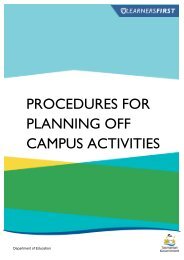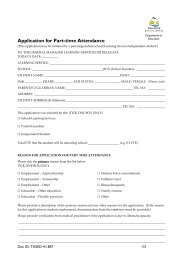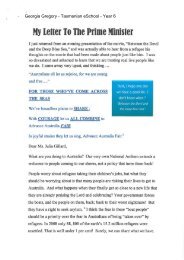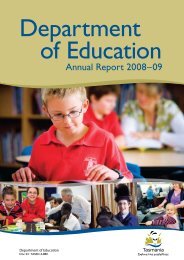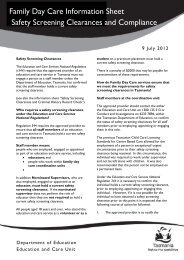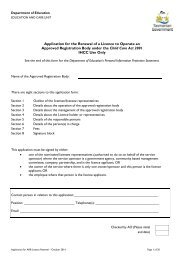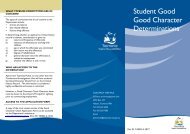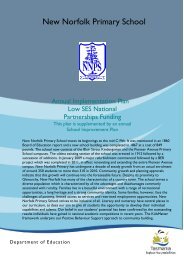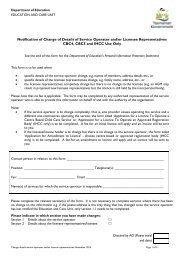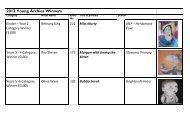Department of Education
DoE Annual Report 2010-2011 - Department of Education
DoE Annual Report 2010-2011 - Department of Education
- No tags were found...
Create successful ePaper yourself
Turn your PDF publications into a flip-book with our unique Google optimized e-Paper software.
2.11<br />
Expenses<br />
from<br />
transactions<br />
Expenses are recognised in the Statement <strong>of</strong><br />
Comprehensive Income when a decrease in future<br />
economic benefit related to a decrease in asset or an<br />
increase <strong>of</strong> a liability has arisen that can be measured<br />
reliably.<br />
a) Employee benefits<br />
Employee benefits include, where applicable,<br />
entitlements to wages and salaries, annual leave, sick<br />
leave, long service leave, superannuation and other<br />
post-employment benefits.<br />
b) Depreciation<br />
All applicable non-financial assets having a limited useful<br />
life are systematically depreciated over their useful lives<br />
in a manner which reflects the consumption <strong>of</strong> their<br />
service potential. Land, being an asset with an unlimited<br />
useful life, is not depreciated. Heritage assets are also<br />
not depreciated as their value does not diminish.<br />
Depreciation is provided for on a straight-line basis,<br />
using rates which are reviewed annually. Major<br />
depreciation periods are:<br />
Plant and equipment<br />
Buildings (masonry)<br />
Buildings (timber framed)<br />
Buildings (steel framed)<br />
Sundry structures<br />
Infrastructure<br />
Library book stock<br />
3–30 years<br />
60 years<br />
50 years<br />
50 years<br />
30 years<br />
80 years<br />
10–25 years<br />
The department undertook a revaluation <strong>of</strong> its land,<br />
buildings and heritage assets during 2009–10. As part <strong>of</strong><br />
this revaluation exercise the department reviewed and<br />
amended the useful lives <strong>of</strong> its building and related assets,<br />
as per the lives in the above list. These amendments<br />
were made based on advice from the valuers, Liquid<br />
Pacific Holdings Pty Ltd. For further details refer to note<br />
9.3(c).<br />
c) Supplies and consumables<br />
Supplies and consumables are recognised when the<br />
items have been received by the department.<br />
d) Grants and subsidies<br />
Grants and subsidies expenditure is recognised to the<br />
extent that:<br />
• the services required to be performed by the grantee<br />
have been performed; or<br />
• the grant eligibility criteria have been satisfied.<br />
A liability is recorded when the department has a<br />
binding agreement to make the grants but services have<br />
not been performed or criteria satisfied. Where grant<br />
monies are paid in advance <strong>of</strong> performance or eligibility,<br />
a prepayment is recognised.<br />
e) Other expenses<br />
Other expenses are recognised when the associated<br />
service and supply has been provided.<br />
2.12<br />
Other<br />
economic<br />
flows<br />
included in<br />
net result<br />
Other economic flow measures the change in volume<br />
or value <strong>of</strong> assets or liabilities that do not result from<br />
transactions.<br />
a) Gain/(loss) on sale <strong>of</strong> non-financial assets<br />
Gains or losses from the sale <strong>of</strong> non-financial assets are<br />
recognised when control <strong>of</strong> the assets has passed to<br />
the buyer.<br />
b) Impairment – financial assets<br />
Financial assets are assessed at each reporting date<br />
to determine whether there is any objective evidence<br />
that there are any financial assets that are impaired. A<br />
financial asset is considered to be impaired if objective<br />
evidence indicates that one or more events have had<br />
a negative affect on the estimated future cash flows <strong>of</strong><br />
that asset.<br />
An impairment loss, in respect <strong>of</strong> a financial asset<br />
measured at amortised cost, is calculated as the<br />
difference between its carrying amount, and the<br />
present value <strong>of</strong> the estimated future cash flows<br />
discounted at the original effective interest rate.<br />
All impairment losses are recognised in the Statement<br />
<strong>of</strong> Comprehensive Income.<br />
An impairment loss is reversed if the reversal can be<br />
related objectively to an event occurring after the<br />
impairment loss was recognised. For financial assets<br />
measured at amortised cost and available-for-sale<br />
financial assets that are debt securities, the reversal is<br />
recognised directly in equity.<br />
c) Impairment – non-financial assets<br />
All non-financial assets are assessed to determine<br />
whether any impairment exists. Impairment exists<br />
when the recoverable amount <strong>of</strong> an asset is less than<br />
its carrying amount. Recoverable amount is the higher<br />
<strong>of</strong> fair value less costs to sell and value in use. The<br />
department’s assets are not used for the purpose <strong>of</strong><br />
generating cash flows; therefore value in use is based on<br />
depreciated replacement cost where the asset would be<br />
replaced if deprived <strong>of</strong> it.<br />
All impairment losses are recognised in the Statement<br />
<strong>of</strong> Comprehensive Income unless a credit exists for the<br />
same class <strong>of</strong> asset in the asset revaluation reserve.<br />
In respect <strong>of</strong> other assets, impairment losses recognised<br />
in prior periods are assessed at each reporting date<br />
for any indications that the loss has decreased or no<br />
longer exists. An impairment loss is reversed if there<br />
has been a change in the estimates used to determine<br />
the recoverable amount. An impairment loss is reversed<br />
only to the extent that the asset’s carrying amount does<br />
not exceed the carrying amount that would have been<br />
determined, net <strong>of</strong> depreciation or amortisation, if no<br />
impairment loss had been recognised.<br />
98<br />
Financial Statements – Notes



